Text

🎹 Bravo to Our Talented Students! 👏
1️⃣Brilliant solo performance😍
2️⃣Culminating months of practice beautifully 💫
3️⃣So proud of our young musicians! 👏
Thank you, students, parents & attendees! 😊
🌐http://kandmmusicschool.com
K&M Music School Students Recital February 4th, 2024
0 notes
Text
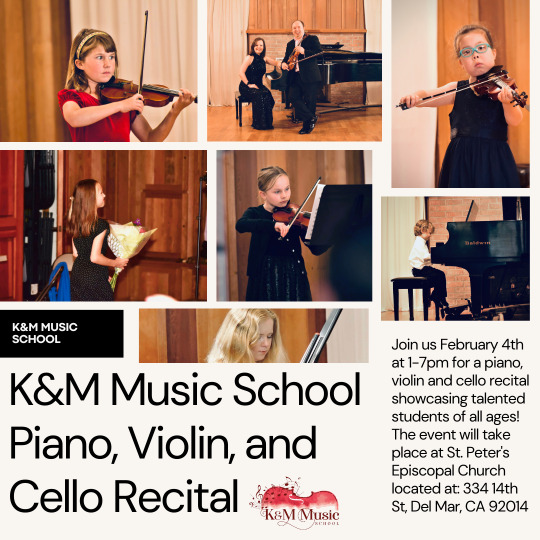
🎶 K&M Music School Student Recital 🎶
🎼Join us on February 4th from 1-7pm 🎹🎻
👏The event will take place at St. Peter's Episcopal Church
🏛️ located at 334 14th St, Del Mar, CA 92014.
🌐http://kandmmusicschool.com
🔥Follow K&M Music School
K&M Music School Student Recital
0 notes
Text
Impactful Even Today: The Cultural Legacy of Romantic Music
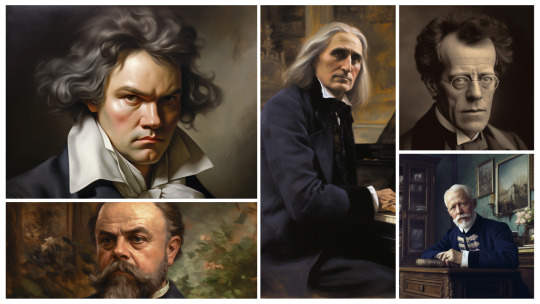
Romantic music’s monumental influence is still felt today. How innovations in lyricism, form, and virtuosity continue shaping cinematic scores, popular music, and fantastical audiovisual works. Timeless inspiration.
The Romantic period from circa 1800-1900 profoundly shaped classical music evolution and perceptions of emotional expression in sound. As innovators, Romantic composers asserted individualism while expanding sonic resources and poetic sensibilities. Their cultural legacy persists not just in enduring repertoire, but through continuous influence across entertainment. This article explores the lasting ripples stemming from musical Romanticism.
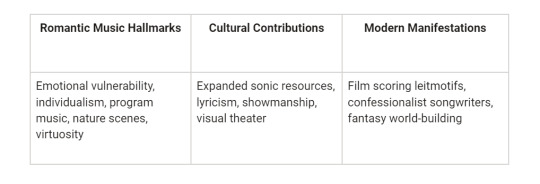
Defining Musical Romanticism
Romanticism across all art forms was a reaction against the rigid rational rules of the Enlightenment era. Music emphasized:
Individualism - Creative self-expression over conformity
Emotion - Music as a subjective reflection of feelings
Nature and the supernatural - Mystery, awe, spirituality
Composers manifested these concepts through lyricism, richer harmonies, and larger musical forms like program symphonies and music dramas. The era birthed beloved masterworks still embodying Romanticism today.
Core Tenets
Some core Romantic beliefs:
Imagination and emotion had cognitive value along with reason
The subjective experience took focus over objective absolutes
Individual liberty and originality should be cultivated
People should follow inner truth over societal expectations
There was redemptive power in beauty, creativity, love
These ideals took musical shape through pioneering new modes of intimate expression.
Emotionalism and Individualism
With ideals valuing imagination and inward experience, Romantic music became a vehicle for intimate personal statements. Composers crafted unique voices through:
Unfettered emotional vulnerability - Joy, despair, triumphs laid bare
Originality and experimentation with form, harmony, sonority
Freedom from rigid rules binding previous eras
Works aimed not just to impress, but impart the elusiveness and extremes of human feeling.
Audiences listened for authentic glimpses into creators’ minds through musical self-portraits. Notions of music explicitly representing the individual carry forward today.
Cult of the Solitary Artist
The archetype of the solitary tormented artist crafting works in isolation took hold. Composers wrote for self-understanding rather than society. They became revered as visionaries channeling truths beyond everyday experience.
The mythology surrounding the alienated, melancholy creative genius persists through figures like Kurt Cobain, Emily Dickinson, and Banksy. Romantic musical icons pioneered that imprint.
Literary and Visual Inspiration
Romantic composers sought to unite the emotional saturation of poetry, novels, art, and nature scenes with musical storytelling.
Program music referenced extramusical ideas through:
Storytelling titles - Evoking imagery, characters, and dramas
Literary motifs and musical themes unify a narrative
Sonically portraying the dynamic natural world or fantastical legends
Matching tonal colors and articulation choices to poetic verses
Listeners clung to these aural landscapes revealing the inner lives of beings real and imagined.
Background Influences
Societal developments enabled Romanticism, like:
Philosophy expounding individual rights
Fascination with wilderness and medieval tales
Gothic revival architecture signifies emotion
Literature exploring psychology and nature as mirror for principles
Composers absorbed these influences as creative inspiration.
Musical Depictions
Some typical Romantic musical motifs sought to reflect:
Mythic heroes, legends, folklore
The sea, mountains, and forests aligned to moods
Dreams, the psyche, spirituality
Medieval life, wars, fairytales
These remain touchstones for soundtracks and music-channeling narratives today.
Virtuosic Performers
The expanding expressive reach of instruments paralleled rising virtuoso performers pushing physical boundaries.
Audiences were magnetized by celebrity pianist-composers like Liszt and Paganini exhibiting sheer technical prowess matched by artistic sensitivity. A cult of personality around lauded interpreters emerged.
Traditions like the piano recital and concerto cadenza spotlighting bravura skills descend directly from the spectacle of Romantic performers. Projecting indomitable presence remains expected from concert soloists.
Performer Showcases
Romantic musicians had tailor-made forums for talent spectacle via:
Flamboyant piano recitals
Concerti featuring cadenzas
Chamber music emphasizes instruments equally
Arias showcasing vocal range and emotion
Opera staging becoming more elaborate
Technical mastery was celebrated rather than hidden.
Virtuoso Archetypes
The 19th-century virtuoso as creative genius archetype gets revived frequently through public figures like Jimi Hendrix, Michael Jackson, Serena Williams, and Johnny Weir known as much for talent and individuality as works produced.
Expanded Musical Resources
Romantic composers drastically expanded the sonic possibilities of instruments through:
Larger orchestras with added brass and exotic instruments
Piano building innovations extending range and resonance
Chromatic woodwinds like bass clarinet broadening instrumental color
Opera production similarly scaled up, incorporating:
Lush orchestration and amplified choruses
Theater technology enhancements like gas lighting
Intensified musical drama and psychological depth
These enlarged canvases of expression suited epic narratives with supernatural settings or existential scope beyond everyday life.
Piano Evolution
Rapidly evolving piano design advanced capabilities:
Metal bracing allows greater string tension and volume
Fully chromatic keyboards
Sustaining and soft pedals augment control
This expanded virtuosic possibilities as the piano became the ultimate Romantic instrument.
Opera Spectacle
Trends towards heightened theatricality included:
More historically accurate staging and costuming
Elaborate sets and special effects like electrical lighting innovations
Ballet interludes provide a spectacle
Larger choruses and orchestras wrapped around singers
Lasting Cultural Impact
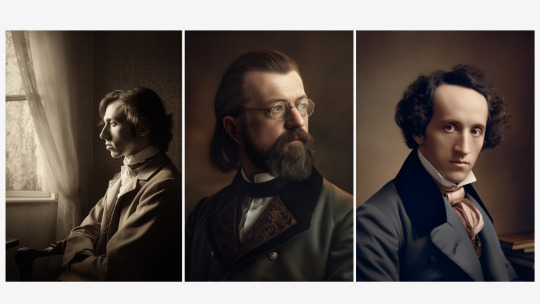
While the Romantic period ended over a century ago, its musical legacy continuously reverberates through aspects of entertainment culture today.
Cinematic Music
Conventions of film scoring closely follow Romantic models, using:
Character leitmotifs - Musical cues attached to protagonists/ideas
Underscoring - Music influencing the perception of the unfolding drama
Expressing magic and wonder through swelling instrumental effects
This emotional enhancement of the story owes greatly to the Romantic playbook.
Lyrical Rock and Pop
The lyrical emphasis in genres like folk, rock ballads, and musical theater also build upon Romantic ideals of the piece reflecting some truth of internal life. Confessional singer-songwriters ruminating philosophically descend directly from the lineage of musical poetry established by Schubert, Schumann, and Brahms.
Fantastical World Building
In spectacles of fantasy Metal, prog rock, and even music videos, the immersed escapism into Nature's extremes, surreal dreamscapes, or mythological immensity channels the same Romantic poetic ideals through modern sound and vision.
These homages reveal that while the period faded, its spirit still compels artists towards utmost emotionality and imagination defying earthly bounds.
Conclusion
While the Romantic period transpired over a century ago, appreciating its pioneered musical innovations remains relevant. Core ideals reverberate through what music we create and consume today - fostering festival headliner god worship and bedroom poster daydreams far exceeding reality. Through maximizing music's emotional saturation and metaphoric reach, Romantic composers granted sound access.
Frequently Asked Questions
How did Romantic music differ from prior classical eras?
It emphasized individual creative freedom, intense emotions, and extra-musical inspiration from poetry/art/nature over rigid rules.
What lasting impacts did Romantic pianist-composers have?
They advanced piano technique and form while establishing the recital tradition showcasing virtuosity and personality.
How were larger orchestras and operatic productions developed in the Romantic period?
Orchestras grew through more brass, chromatic woodwinds, and divided strings. Operas became more theatrically immersive spectacles.
How do today’s movie soundtracks inherit from Romantic music?
Their emotional enhancement of unfolding drama through leitmotifs and atmospheric underscoring closely follow Romantic models.
What modern songwriting traditions descend from the Romantics?
Confessional lyrical styles emphasizing introspection and sonic scene setting continue the lineage of Schubert and Schumann’s musical poetry.
How do Romantic principles shape today's arts/entertainment?
Reverence for intense emotionality, imagination, and psychological vulnerability in artistic statements still compels creators today.
What lasting impacts did the Romantic musical ethos have?
It enshrined music composition and performance as conduits for intimate self-expression to channel profound facets of human experience.
#Romanticism#MusicalLegacy#ComposersWhoChangedCulture#EmotionInMusic#VirtuosityThenAndNow#StorytellingSounds#CinematicScores
0 notes
Text
Master Expressive Violin Vibrato with Pro Tips and Daily Exercises
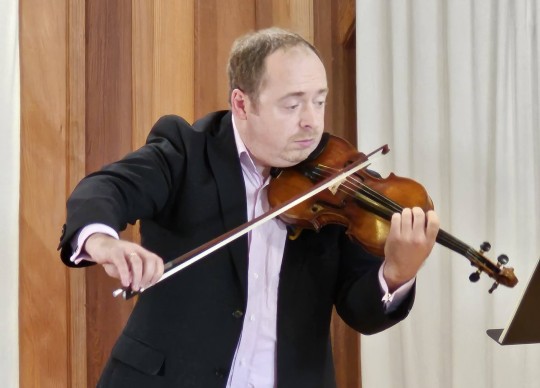
Vibrato is an essential violin technique that adds expression and emotion to the sound. Mastering a flexible, controlled vibrato requires daily focus and targeted exercises. This in-depth guide provides tips to develop violin vibrato technique properly along with sample practice routines to enhance mastery.
Vibrato brings the violin to life with passion and color. Learning efficient motion and integrating it musically into playing elevates phrasing. With patience and deliberate practice, any violinist can develop an expressive, shimmering vibrato. Let's get started!
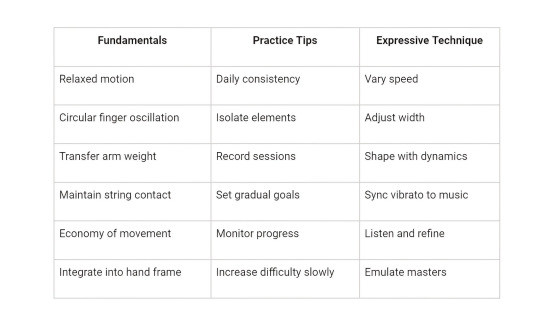
What is Violin Vibrato?
Vibrato is a rapid, constant fluctuation in pitch that adds expression and interest to violin notes. It gives the characteristic warmth and personality to the sound.
Vibrato is produced by small, regular finger motions while maintaining contact with the string. This causes slight variations in pitch that enhance tone. Vibrato can also be created using wrist or arm movements.
There are several types of violin vibrato:
Finger vibrato - subtle fingertip rocking back and forth
Wrist vibrato - flickering hand motion at the wrist
Arm vibrato - larger oscillation from the elbow
Violinists utilize different speeds and widths of vibrato for varied effects. Mastering control of this technique is a milestone of accomplished violin playing.
How Violin Vibrato Creates Fluctuating Pitch
Violin vibrato works by slightly shortening and lengthening the string length through finger motion:
Rocking the fingertip back lifts the string slightly, shortening the length, and raising the pitch
Rocking forward lowers the string, increasing the length, and lowering the pitch
This creates an oscillating fluctuation between higher and lower pitches
The result is a rich, warm pulsating sound at the main note pitch
This pitch wavering adds interest, emotion, and vocal-like sounds.
Notation for Violin Vibrato
Composers use the following notation to indicate vibrato:
Wavy line above or below note
"Vib." or "non-vib." written instructions
Changes in line width show variations in speed or width
Listen to recordings to interpret the intended vibrato style.
Benefits of Developing Strong Vibrato Skills
Here are some of the key benefits that vibrato brings to violin playing:
Adds beautiful warmth and richness to the tone quality
Allows dynamic, nuanced musical expression
Enables tone color variations from bright shimmers to romantic intensity
Elevates phrasing and makes the violin "sing"
Prevents monotony by adding interest to long notes
Provides an outlet for emotion through the instrument
Benchmark of advanced violin technique mastery
Makes amateur playing sound more professional
Vibrato is not just an add-on effect - it becomes an integral part of the violinist's sound. Mastering expressive vibrato technique elevates playing to a more professional level.
More Than Just Ornamentation
Vibrato is sometimes mistakenly viewed as just ornamentation added onto notes. But truly mastered vibrato:
Becomes an unconscious, integral part of sound production
Is used expressively on virtually every sustained note
Enhances the core tone, not just decorates it
Helps communicate phrasing, emotion, and musicality
Aim to make vibrato a natural extension of your artistic intentions, not just a technique attached to notes.
Violin Vibrato is Expected
For aspiring violinists, here’s some motivation:
Audiences, teachers, and fellow musicians expect violinists to use vibrato
Lack of vibrato sounds amateur, dull, or emotionless
The Vibrato technique is required for advanced repertoire
Using vibrato well projects passion and musicality
Put in the work, and your effort will be rewarded with rich sounds.
Proper Violin Vibrato Technique Fundamentals
Developing efficient, flexible vibrato requires establishing these core techniques:
Relaxed, supple wrist and arm motion
Small, circular fingertip rocking movement
Completely smooth, even oscillation between slightly raised and lowered finger positions
Maintaining constant contact between fingertip and string
Allowing arm weight to transfer through the finger to the string
Using the entire forearm, not just the wrist or hand
Integrating motion into the hand frame without tension or extra motion
Slow, mindful practice establishes proper motion and feel. Vibrato must become second nature to use expressively. Master the basics first before attempting to vary vibrato effects.
Relaxation is Crucial
Tension hinders vibrato development. Always monitor for:
Tight, rigid wrist, arm, or shoulder
Gripping motion in the hand
Pressing fingers down harshly on strings
Collapsing knuckles or bent fingertips
Relax muscles fully. Let arm weight flow into the fingertip.
Efficient, Economical Motion
Strive for:
Minimal extraneous motion in hand or arm
Fingertip moves slightly up and down, hand frame stays steady
Smooth circles, not back-and-forth or diagonal rubbing
Just enough motion to fluctuate pitch, not more
Any tension or extra motion inhibits speed and flexibility.
Useful Daily Exercises for Improving Violin Vibrato
Dedicated daily practice of targeted vibrato exercises builds technique efficiently. Here are some useful drills:
Flexibility and Motion Exercises
Gently roll wrists in circles to increase suppleness
Stretch wrists carefully within a comfortable range of motion
Massage forearms and wrists to relax muscles
Rotate arms at the elbow to prepare for arm vibrato
Basic Finger Motion Practice
While seated, tap fingertips together in a controlled, pulsating rocking motion
Start with a slower tempo, increase finger speed over time
Focus on maintaining completely steady, even oscillation
Finger Rolls on the Violin
With violin supported, place finger on string with normal frame
Roll fingertip evenly up and down while keeping contact with the string
Control speed and narrow the motion as coordination develops
Vibrato on Open Strings
Apply basic vibrato finger motion to open strings
Start very slowly and gradually increase the oscillation speed with the metronome
Use arm weight to allow motion to transfer through the finger to the string
Integrating Vibrato into Scales and Songs
First perfect notes, shifts, and intonation without vibrato
Add vibrato on long-held notes at the ends of phrases
Increase the amount of vibrato as technical skill improves
Use vibrato stylistically to complement the music
Isolating Each Element
Practice aspects separately before combining:
Flexibility drills only
Basic finger motion only
Finger roll on the violin without a sound
Open string vibrato focus
Add vibrato sparingly to the repertoire
This develops and ingrains proper technique.
Developing an Expressive, Musical Violin Vibrato
Once the basics are established, work on varying your vibrato for expressive effects:
Adjust oscillation speed for different impacts - slow can be sweet, fast more intense.
Modify width from very narrow vibrato to wide, dramatic shimmers.
Add accents or crescendos/decrescendos during vibrato notes.
Sync vibrato with phrase shaping, dynamics, and emotions of the music.
Listen to recordings of great violinists to inspire artistic vibrato use.
With mastery, vibrato becomes an intuitive tool for highlighting the music's phrasing and passion. An expressive vibrato transports listeners.
Speed, Width, and Shape
To vary vibrato:
Faster = more intensity and excitement
Slower = sweetness and meditation
Wider = bigger dramatic shimmers
Narrower = delicate flutter
Shape vibrato with crescendos, accents, and varied speed/width
Syncing with Music
Sync choices to phrasing or emotion:
Slow, narrow vibrato on soft lyrical sections
Pulsing, passionate vibrato on loud, dramatic phrases
Adding/increasing vibrato towards a climax note
Let the music influence your vibrato decisions.
Tips for Practicing Violin Vibrato Exercises

Here are some useful tips for getting the most out of daily vibrato practice:
Mindful Repetition
Thoughtfully repeat each exercise, focusing intently on the proper motion. Quality matters more than quantity. Don't allow flaws to get ingrained.
Use a Metronome
Set the metronome slow and increase tempo gradually over time to monitor oscillations. A steady rhythm is key.
Record Yourself
Record videos to watch your hand motion and analyze your vibrato sound. Strive for continuous, flawless oscillations.
Take Breaks
Frequent short sessions are better than marathon practice. Give muscles recovery time to increase flexibility safely.
Increase Difficulty Slowly
Start on open strings with easy whole notes. Only advance to a more complex repertoire, dynamics, and tempi once simple is mastered.
Listen Critically
Develop your “vibrato ear.” Identify and correct any unevenness, nervous shaking, or lack of continuity.
Stay Patient and Positive
Don’t get discouraged. Daily dedication leads to vibrato success. Celebrate small improvements.
Consistent, attentive exercises ingrain proper vibrato technique automatically over time.
Troubleshooting Common Violin Vibrato Problems
Here are solutions to some typical challenges students face:
Uneven, shaky vibrato: Relax wrist and arm fully. Move just the fingertip, not the whole hand. Control speed with a metronome.
Not continuous: Maintain constant finger rocking. Don't stop/start oscillation. Eliminate any pauses.
Finger loses contact: Touch the string very lightly. Allow arm weight to transfer through the fingertip.
Sounds too wide/narrow: Adjust finger motion width and listen critically to match music.
Hand tenses up: Check for tension. Shake hands out. Soften grip.
Pressing too hard: Light fingertip contact. Move arm weight into rocking finger.
Adding vibrato late: First practice note change without vibrato. Then add immediately when changing notes.
Analyze issues, isolate elements, and do focused exercises to correct them.
Integrating Vibrato into Violin Repertoire
One fundamental technique is established through exercises, start incorporating vibrato into varied repertoire:
Add vibrato to long notes initially, then expand to more notes as skills improve
Prioritize vibrato on emphasized notes like at the ends of phrases
Use appropriate speed and width for the piece's mood and style
Avoid tension by keeping a relaxed motion established in exercises
Let vibrato enhance the music's phrasing, not obscure it
Gradually increase vibrato as technical control develops. Use it to accentuate musical ideas.
Choosing Vibrato Points
When deciding where to add vibrato:
Vary it more in slow lyrical sections, and less in fast technical passages
Prioritize long notes first to emphasize passion
Highlight climax notes at the ends of phrases
Use selectively for contrast between non-vibrato and vibrato notes
Listen and experiment. Let the music guide your expressive choices.
Developing Consistency in Practice
Achieving an expressive vibrato requires dedication through daily practice. Here are tips:
Make it a Routine
Commit to regular short sessions - 10 minutes daily is ideal
Consistency over time brings cumulative improvement
Track and Measure Progress
Record sessions to compare against past vibrato attempts
Note tempo markings of metronome settings you can handle
Quantify measures like oscillation speed, width, duration
Set Gradual Goals
Add one more note with vibrato
Increase metronome speed by 1 notch
Sustain vibrato for 2 extra beats
Analyze and Refine
Review recordings, and identify issues to improve
Compare sound to professional vibrato examples
Adjust technique and repeat focused exercises
Celebrate Small Wins
Recognize any sign of progress
Avoid getting discouraged if advancing slowly
Remind yourself success comes through practice over time
Fostering a growth mindset keeps you moving forward. Consistency is key.
Vibrato Exercises to Include in Daily Practice Routine
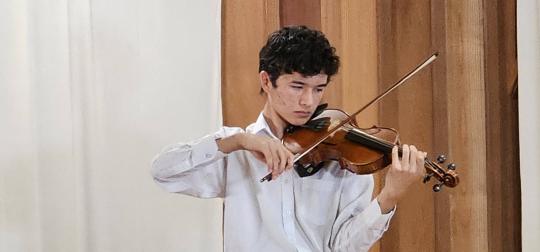
To simplify establishing a regular practice routine, here are suggested vibrato exercises to cycle through daily:
Monday
Wrist rolls, arm circles, stretching (5 minutes)
Basic finger motion at increasing metronome tempi (3 minutes)
Open D string vibrato whole notes (2 minutes)
Tuesday
Wrist/arm massage, fingertip tapping (5 minutes)
Rolls on all open strings, one string at a time (3 minutes each)
Apply vibrato to open A and E strings (2 minutes each)
Wednesday
Wrist and arm flexibility drills (5 minutes)
Finger rolls on each string, half note duration (3 minutes each)
Vibrato octave scales on D and A strings (2 minutes each)
Thursday
Arm rotations, knuckle stretches (5 minutes)
Vibrato finger taps at a fast tempo (3 minutes)
Add vibrato to repertoire pieces (5 minutes)
Friday
Full relaxation and massage of arms (5 minutes)
Advance metronome speed on open string whole note vibrato (3 minutes)
Play repertoire pieces with added vibrato (5 minutes)
Saturday
Flexibility exercises for wrist and arm (5 minutes)
Open string vibrato with varying speeds (3 minutes)
Practice vibrato in challenging repertoire sections (5 minutes)
Sunday
Gentle stretches, wrist rolls, fingertip tapping (5 minutes)
Play repertoire pieces from start to finish with added vibrato (10 minutes)
Cycling through a sequence like this ingrains skills through consistency. Adjust and expand exercises as you progress.
Putting it All Together
Learning violin vibrato requires diligent daily practice of proper relaxed technique. Isolate elements like flexibility, basic finger motion, applying to open strings, and adding judiciously to the repertoire. Listen critically and assess recordings of your progress. Using expressive, musical vibrato will elevate your level of playing and unlock the violin’s full tonal palette. With patience and consistency, work through challenges one by one. The beautiful reward of a flexible, singing vibrato is well worth the effort.
Let me know if you would like me to expand or modify any part of this comprehensive vibrato guide. Please share any feedback on areas I can improve. I aimed to thoroughly cover how to develop excellent violin vibrato techniques through dedicated practice.
FAQ
What is the proper violin vibrato motion?
A relaxed, circular rocking of the fingertip that transfers arm weight into the string to create a fluctuating pitch.
How can you practice violin vibrato efficiently?
Isolate aspects like flexibility, basic motion, and open strings. Add judiciously to the repertoire. Record and assess your progress.
How do you vary vibrato for musical expression?
By adjusting speed, and width, adding dynamic shapes, and syncing choices to the phrasing and mood of the music.
What are some common vibrato challenges and how to fix them?
Uneven or shaky vibrato - relax your arm and control your speed. Hand tensing up - release grip, reduce pressing.
How should you choose which notes to add vibrato to?
Prioritize long notes, ends of phrases, and climaxes. Consider the mood and style of the music.
How long does it take to develop a good violin vibrato technique?
It requires consistent daily practice over months or years. Have patience and celebrate small achievements.
Why is recording yourself important?
Analyzing recordings helps identify and correct any technical flaws before they get ingrained.
#Violin Vibrato Techniques#Expressive Violin Playing#Advanced Violin Skills#Vibrato Practice Exercises#Musical Expression#String Instrument Techniques#Violin Performance Tips#Classical Music Training#Violin Finger Techniques#Violin Teaching Methods#Daily Violin Practice#Violin Warm-Up Exercises#Mastering Vibrato Speed#Vibrato Width Control#Emotional Phrasing on Violin#Violin Technique Improvement#Artistic Violin Performance#Violin Tone Enrichment#Professional Violinist Tips#Violin Practice Routine
2 notes
·
View notes